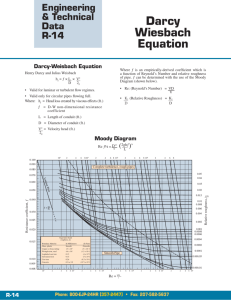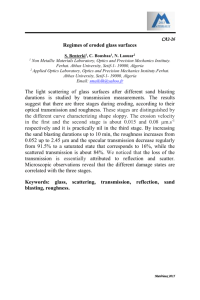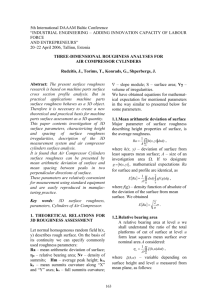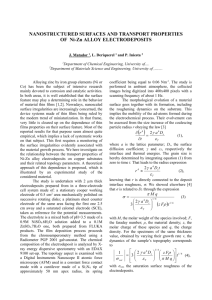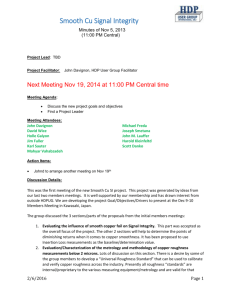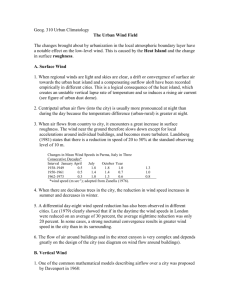Seagate Design Group
advertisement
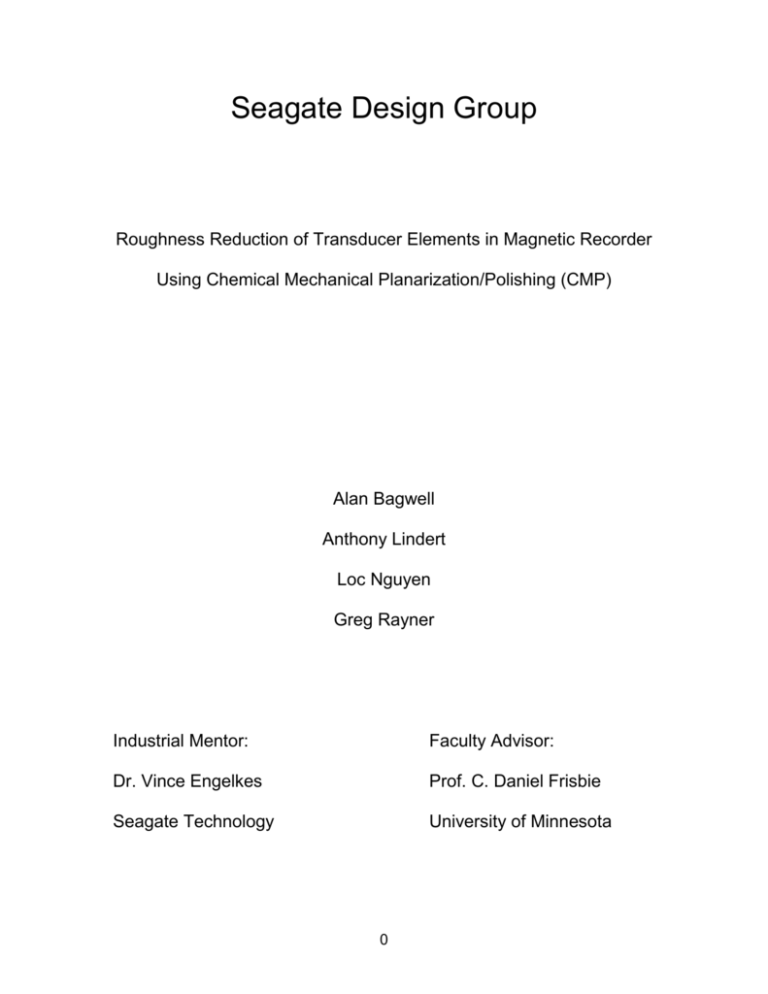
Seagate Design Group Roughness Reduction of Transducer Elements in Magnetic Recorder Using Chemical Mechanical Planarization/Polishing (CMP) Alan Bagwell Anthony Lindert Loc Nguyen Greg Rayner Industrial Mentor: Faculty Advisor: Dr. Vince Engelkes Prof. C. Daniel Frisbie Seagate Technology University of Minnesota 0 Abstract The objective of the design is to reduce the RMS roughness value of the transducer of the recording head from the current value of 10Å to 2Å. Reducing the roughness will allow the flight height, currently at 10nm, to be set to a lower value. Decreasing the flight height will improve reliability and performance of the read and write processes. Chemical mechanical planarization/polishing is the best solution in terms of cost, time, ease of implementation, and achieving final RMS roughness value of 2Å. Slurry and abrasive choice is the main focus for improving the CMP process. 1 Introduction The goal of this project is to design a fabrication process to reduce the roughness of the transducer, which contains the reader and writer elements of the recording head. Currently the transducer region (Figure 1) has a 10Å root mean square (RMS) roughness value measured with an Atomic Force Microscope (AFM)1. RMS roughness is a surface roughness statistical value for the differences in surface height from an average surface height value2. The objective is to reduce the RMS roughness value from 10Å to 2Å. Figure 1. Hard drive recording slider (left) and cross sectional view of the transducer (right). Images from “Materials for Electronics” by Dr. Marcus Mooney from Seagate Technology. Roughness reduction is crucial in improving the performance of the reader and writer functions. Current clearance between the reader/writer and the magnetic recording platter is 10 nm; this is also known as “flight height” 1. 1 2 Dr. Vince Engelkes from Seagate Technology. ASM Handbook: Volume 18. ASM International, 1992, page 332. 2 Reducing the roughness of the transducer will allow the clearance distance or flying height to be reduced. This will increase the signal-to-noise ratio of the reader/writer elements and the magnetic data on the platter, leading to improvement in reliability and performance. Reducing the transducer roughness will also increase the life of the hard drive, because it decreases the probability of collision between the recording head and the media3. 3 Effects of Media Burnish Capability to Head-Disk Clearance. Li, Chen, Liu, Gao, and Demczyk. 3 Possible Solutions The main objective for this design is to reduce the roughness of the transducer area from 10Å to 2Å RMS roughness value. One possible solution is to modify and/or add an additional chemical mechanical planarization/polishing (CMP) step; CMP is currently used in Seagate’s wafer fabrication process. CMP is defined as: “A process that uses an abrasive, corrosive slurry to physically grind flat and chemically remove the microscopic topographic features on a wafer so that subsequent processes can begin from a flat surface4.” The abrasive is the mechanical part in CMP and is usually diamond, cerium, or alumina particles. The corrosive slurry is the chemical part of CMP and is usually a liquid with low or high pH value5. Since Seagate already uses some form of CMP in their fabrication process and already has the necessary equipment, the benefits of this process are that it will be easy to implement and will have a low cost. Because there are a number of different materials with different moduli, the disadvantage will be difficulty in obtaining a controlled flat surface. Softer materials lapped or have a higher removal rate than harder materials, thus leading to a higher roughness value. Literature shows that reduction in RMS roughness value below 1Å is possible through CMP of a single material. Further research in the area of slurry 4 www.appliedmaterials.com/products/cmp_4.html. 3/2/2009 “Processing considerations for CMP on thin-film head wafers” by Ming Jiang. Solid-State Technology. September 2004. 5 4 type, polishing pad, lapping plate speed, and wafer pressure is needed to accomplish the project goal. Another possible solution is a process known as “Spin-on Glass” (SOG). SOG is a process that uses a liquid form of glass to fill small gaps, cracks, and/or voids between metal layers6. This process is widely used in the fabrication of circuit boards. According to Honeywell Electronic Materials, SOG using siloxanes have the ability to fill gaps or voids as small as 1Å. SOG process involves pouring glass liquid over a spinning wafer after each deposition to fill in voids. This ensures a planarized wafer at the end of deposition fabrication, which can lead to a more uniform polishing or smaller RMS roughness value from CMP. Lapping and removal rate will be more consistent if the surface is filled compared to a surface with crack and voids. The advantages of SOG are that it is relatively easy to implement and low cost. The only cost for this process is the simple tool to hold and spin the wafer, liquid glass, and the time to perform the process after each deposition stage. The key disadvantages of SOG are possible material contaminations and thus a possible reduction in magnetic and electrical properties of the reader/writer operations. The third possible solution is to use a focused ion beam (FIB) to mill and polish the transducer region. FIB is similar to a scanning electron microscope (SEM) but uses gallium ions rather than electrons for imaging7. Using a focused beam of ions, FIB can also be used to mill or cut away unwanted material with superior accuracy. The advantage of using a FIB for this design is a nearly “Optimization of Spin-On-Glass Process for Multilevel Metal Interconnects”. Aric C. Madayag and Zhiping Zhou. Georgia Institute of Technology 7 http://www.fei.com/products/types/focused-ion-beam-tools.aspx 6 5 perfect polish or sub-angstrom RMS roughness value. The disadvantages of FIB are high machine cost, time, and possible re-deposition and contamination. Milling time can be extensive depending on the amount of material that needs removing. The other concern is the removed material might be re-deposited back onto the surface. This can leads to a decrease in the optimal function of the reader and writer elements. The last possible solution for the design is material change; changing the current materials of the reader/writer elements with materials of similar moduli, but still keeping the same magnetic and electrical properties. Materials with the same modulus will have a more uniform lap rate compared to a wafer with a wide range of moduli. The advantage of material change is better polishing potential. The disadvantage of material change is possible reduction in magnetic and electrical properties. 6 Idea Selection Four weighting factors were considered in the design: cost, time, ease of implementation, and final roughness outcome. Cost factored in any additional monetary needed for extra equipment or supply; it has the lowest weighting factor of 10%. Time accounts for extra time needed for the process; it has a weighting factor of 20%. Ease of implementation refers to how well the selected process can be implemented into the current fabrication process; it has a weighting factor of 30%. Roughness outcome factored in how well the selected process can achieve the final RMS roughness value of 2Å. Ease of implementation and final roughness outcome were given a higher weighting factor because they are part of the design requirements. A rating factor, from 1 to 4, was also given to each process in each of the weighting factor categories; 1 is worst and 4 is best. Table 1 summarizes the different possible processes for the design and the weighting factors. CMP and material change will not require additional equipment or extra processing time, thus they have a high rating factor for both cost and time categories. SOG received a 3 for rating factor in the cost and time categories because it incurs minor costs associated with equipment, liquid glass supply, and extra processing steps. FIB received a 1 rating for cost and time categories because of the extensive equipment cost and lengthy milling time. In the ease of implementation category, CMP received the highest rating because CMP is currently used in Seagate fabrication process, while material change has the lowest rating because it will require a propagated change in the overall 7 fabrication process. For roughness category, FIB received a 4 because it can achieve a near perfect flatness; other processes received a 2 because each process is capable of achieving ideal polished and flatness. Table 1. Idea selection matrix with weighting factors and total score of CMP, FIB, SOG, and material change processes. Idea Selection Process CMP FIB SOG $$S Cost (10%) Time (20%) Ease of Implementation (30%) Roughness (40%) Total Material Change 4 1 3 4 3 1 3 4 4 2 3 1 2 4 2 2 3 2.5 2.6 2.3 According to the selection matrix, CMP is the best solution with a total score of 3. Although chemical mechanical planarization is the current final planarization process in use at Seagate, it is a complicated procedure with many possible methods of improving and optimizing the process to meet the roughness goal of 2Å. As previously stated, CMP consists of a pad which is spun against the substrate and a chemical slurry containing abrasive particles used to simultaneously soften the substrate through chemical means and then polish it flat with mechanical abrasion. The process control mechanisms in CMP are extensive. There are multiple pressure controls, rotator speed settings, slurry release rate, processing 8 temperature, polishing time, slurry type, abrasive type and size, and plate or pad type. Each of these will affect the final outcome of the sample in term of planarity, uniformity, roughness, and polished. With all the different input parameters, the slurry itself is the most important parameter in reducing the substrate roughness. The size and composition of the abrasive particles as well as their average shape has a large impact on final roughness. A proper balanced of chemical and particles’ sizes and shapes for slurry is essential to achieve the design goal of 2Å RMS roughness value. Modification of the slurry will be the main focus for this project. 9 Product Design Specifications (PDS) Roughness Reduction of Transducer Elements in Magnetic Recorder Using Chemical Mechanical Planarization/Polishing (CMP) Goal: Reduce current transducer RMS roughness value of 10Å to 2Å. Technical Requirements: Current transducer RMS roughness is 10Å; ideal RMS roughness should be 2Å. Slider and transducer must be planarized. Zero reduction in current magnetic and electrical properties of reader and writer elements. No contamination and/or negative reaction from slurry or abrasive after CMP. Product life must last at least 5 years or a mean time between failures (MTBF) > 1 million hours usage. Production Requirements: Ease of mass production and fabrication. Cost conscious. 10

